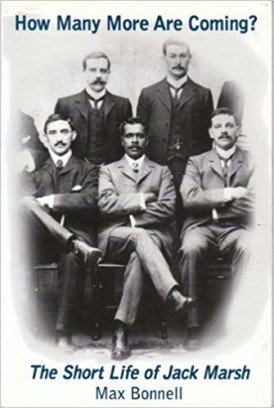How Many More Are Coming?
Martin Chandler |Published: 2003
Pages: 138
Author: Bonnell, Max
Publisher: Walla Walla Press
Rating: 4 stars

It started with Ebley Street Boys which, with its Lancashire connection, I was always going to be happy to read. Boyhood Hero came along so swiftly afterwards that, dealing as it did with a man who helped inspire Donald Bradman, it seemed natural to pick that one up the minute it arrived. After that and given that I had, for a number of years, been meaning to read Currency Lads it wasn’t a difficult decision to finally find the chance to open that once I had finished the story of Johnny Taylor.
Currency Lads was published by The Cricket Publishing Company, a particular favourite with CricketWeb’s Review team ever since we started. At some point in the last few years, and having decided that one of my goals was to acquire copies of all the company’s books, I plucked all of their publications from the shelves in order to put them together – bear with me – I am getting to the point.
A couple of years ago I realised that, back in 2001 when it first appeared, Currency Lads had been published in a limited edition hardback, signed by Bill Brown. The absence of a copy of that limited edition began to trouble me, although I did not have to worry too much as, in the way he often does, Roger Page came to the rescue. This meant that, whilst I was reading my copy of the standard edition of the book, the limited edition went onto the shelf where the standard edition had been, so what was I to do with the trade paperback after I had read it?
The answer seemed obvious, to put it back in the mainstream of my collection, which is stored in alphabetical order, by author. It was only in doing that that I realised that it was Bonnell who had written How Many More Are Coming? so, to my delight, there was still an unread Bonnell. One long afternoon later and I had read this slim biography and was left to reflect on my mistake of assuming, for several years, that someone else had written the book.
How Many More Are Coming? tells of the life and times of a man who played just six First Class matches for New South Wales at the turn of the twentieth century. Despite that many people with a feel for the game’s history will recognise the name of Jack Marsh as one of the first indigenous Australians to have played First Class cricket, although there will seldom be much knowledge beyond that.
Marsh’s life as a professional sportsman began as a sprinter. The fact that there was a professional athletics circuit in Australia in Victorian times was something I had no idea about before reading How Many More Are Coming? and that is itself an interesting story even leaving aside Marsh’s involvement. Bonnell explains how this worked, the handicaps and the betting, and it is easy enough to understand the reason why the sport ceased to flourish in the early years of the twentieth century.
Initially Marsh used his undoubted ability as a cricketer to supplement his running income. He was a fine fast bowler with an unusual and controversial action who was no balled for throwing on a number of occasions. Just how fast Marsh was and whether he did throw are two questions that Bonnell dwells on at length, assembling all the contemporary evidence that is available. There is just one photograph of Marsh in action, so no definitive assessment is possible. The reader is left to conclude however that perhaps Marsh did not have the pace, certainly not consistently, that is sometimes attributed to him, and that perhaps there are rather more parallels between Marsh and Murali than might at first blush seem likely.
Why was Marsh’s career so short? The answer to that is clearly prejudice, and the main culprit was Australian captain Monty Noble who, after Marsh had enjoyed a singularly successful Sheffield Shield season in 1900/01, refused to pick him for New South Wales once he was given sole charge over selection. To what extent the manner in which Marsh was discriminated against was motivated by his race, and how much by genuine concerns on Noble’s part about his action is something that is fully explored, as are prevailing attitudes generally. The vehemence of Archie MacLaren’s objections to Marsh meeting his 1901/02 England tourists is also fully considered, as is the contrasting (in some ways) attitude of England’s next captain, two years later, Plum Warner. Marsh did play in a two day match against Warner’s side with considerable success, but if he ever read the piece he would have been very unhappy about what Warner later wrote about their encounter.
Marsh lived on for more than a decade after he fell out of love with the game, and life for him was a downward spiral after that. He went from being a man whose status was effectively that of an honorary white to an itinerant labourer with an alcohol problem before, in 1916 at the age of around 42, he was killed in a street brawl that he himself was largely responsible for. The words that give the book its title were the last he uttered.
The tragic incident in which Marsh lost his life took place in daylight and there were a number of witnesses. Two men were charged with manslaughter, and subsequently acquitted. Lawyer Bonnell is at his best in explaining what happened inside and outside the court, and he concludes his account of the life of Jack Marsh with a short closing chapter reflecting on what might have been.
How Many More Are Coming? is an unusual story, superbly told by a fine writer.






Leave a comment